A big thank you to Country Walkers for providing this adventure, as always, all opinions are our own.
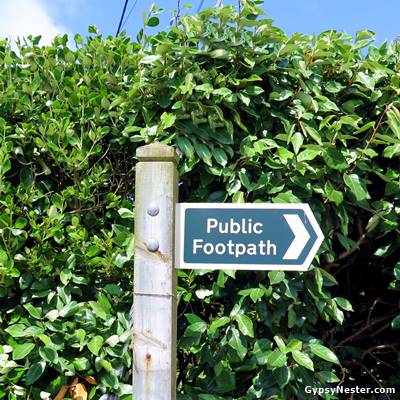
The introductory warm-up walk of our Cornwall walking tour was destined to rock. There was just no way around it, because it would begin and end in the town of Rock.
In order to accomplish this rockin’ trek, we would need to cross the River Camel from our base in Padstow.
No big deal, except for the interesting challenges faced by the ferry in negotiating the enormous tides that occur along this north facing coast on the Celtic Sea.
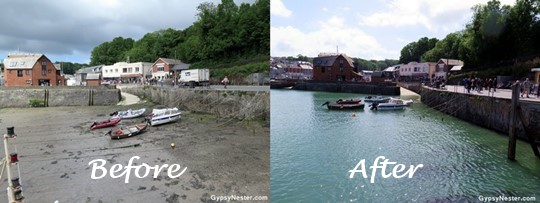
The variance from low to high tide is often over 20 feet. This leaves many boats in the harbor stranded high and dry at the low point, and requires a temporary disembarking spot for the ferry out on a sandbar far from the usual shore.

Once across the bay, we climbed to the high tide shoreline from our makeshift docking location and proceeded along England’s famous South West Coast Path toward the tiny village of Trebetherick.
This bit of trail would be our first of many walks along the country’s longest marked footpath. We wouldn’t come near covering the over six hundred miles of coastline that it spans along the South West Peninsula, but the sections we saw proved to be as scenic as we could have possibly imagined.
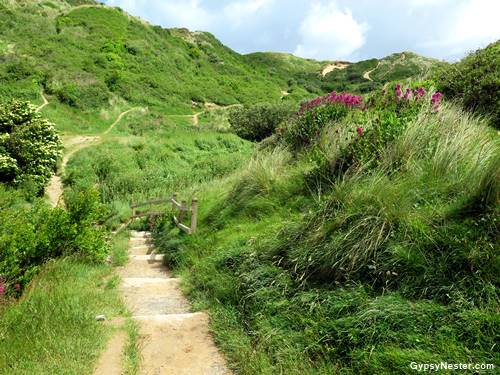 The stretch along the bay ran over and through large sand dunes that have been covered with grassy growth so that the seemingly solid ground beneath our feet was actually continually shifting.
The stretch along the bay ran over and through large sand dunes that have been covered with grassy growth so that the seemingly solid ground beneath our feet was actually continually shifting.
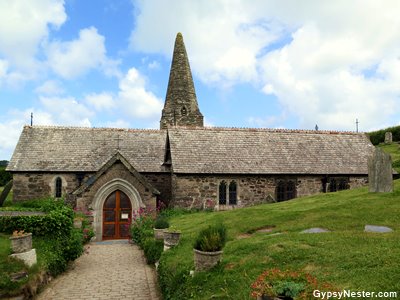 Before long we came to the enduring little Saint Enodoc Church. This stone chapel became known as Sinking Neddy because it looks as though it has sunk into the ground. But looks can be deceiving, actually it has been battling the relentless encroachment of the dunes that have continually conspired to cover it for nearly nine centuries.
Before long we came to the enduring little Saint Enodoc Church. This stone chapel became known as Sinking Neddy because it looks as though it has sunk into the ground. But looks can be deceiving, actually it has been battling the relentless encroachment of the dunes that have continually conspired to cover it for nearly nine centuries.
Today the grass covered dunes rise almost to the roof line, but it would be completely covered if not for a big dig back in 1864 that unearthed the building and stabilized the dunes. For three hundred years before that Neddy was nearly invisible and the only way in was to drop in through a hole in the roof.
This peculiar procedure had to be completed at least once a year for the church to remain a valid parish, so priest and parishioners would make an annual climb down a ladder to attend services.
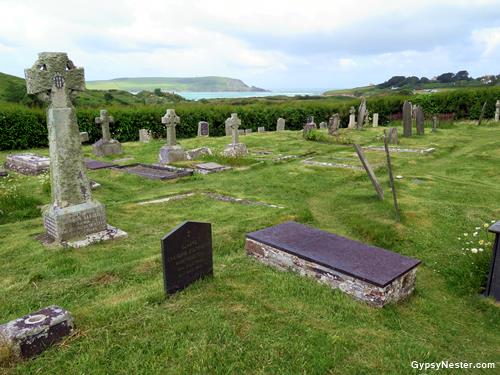 We have always been fascinated with cemeteries, the older the better, and St. Enodoc’s was mesmerizing. Not only for the markers, some of which date back to the sixteen hundreds, but for the scenic placement overlooking the bay.
We have always been fascinated with cemeteries, the older the better, and St. Enodoc’s was mesmerizing. Not only for the markers, some of which date back to the sixteen hundreds, but for the scenic placement overlooking the bay.
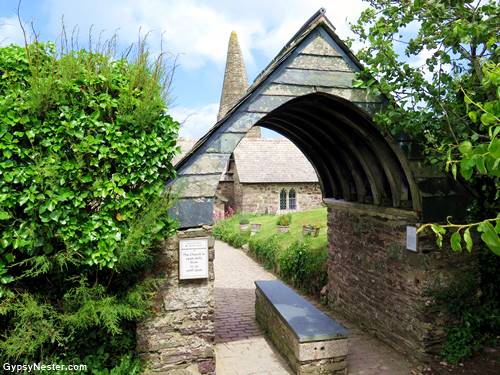 Another interesting feature of the church, which was new to us but that we would encounter many more times again on this trip, was the lychgate we passed through to enter the yard.
Another interesting feature of the church, which was new to us but that we would encounter many more times again on this trip, was the lychgate we passed through to enter the yard.
The word lych, meaning corpse, has survived from Old English and stems the Middle Ages when the dead were brought to the lychgate until a funeral service could be performed. The little structure kept the rain off of, and provided seating for folks keeping vigil.
As we moved off into the countryside we encountered a couple of other new gateways that enabled passage between farmer’s fields. These were both designed to permit people, but not livestock, to pass through.
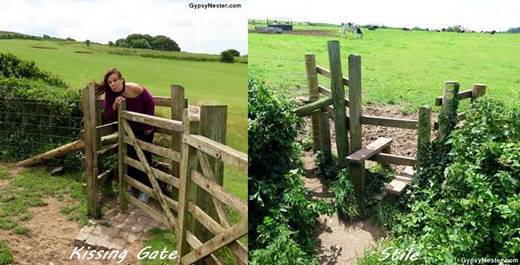
The first, a kissing gate, works by allowing a person to enter inside an enclosure with a gate that can be pushed one way to enter, walked around, then pushed back to permit an exit.
The other, called a stile, is simply a few steps placed so that people but not animals can climb over a fence or wall. We immediately associated the name with the word turnstile, which was correct. The contraption we know from crowd control at stadiums originally was a form of stile used to keep sheep or other livestock penned in.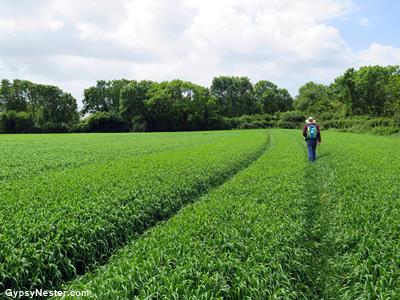
Following our curiosity down an internet rat hole led us to learn that the first use of a turnstile to control the flow of humans was in a Piggly Wiggly store in Memphis, Tennessee.
Passing along hedgerows, and through the meadows and glades, also offered us the opportunity to discover a flower that we had never seen before, the foxglove. Turns out that these beautiful purple bloom covered plants are the source of a medicine called Digoxin that is used to treat heart conditions.

The plant’s medicinal qualities have been known for centuries, with the first published description dating back to the 1785 book An Account of the Foxglove and some of its Medical Uses with Practical Remarks on Dropsy and Other Diseases by physician William Withering.
Mostly we noticed that bees love them. Guess the little bumblers will never have to worry about an irregular heartbeat.
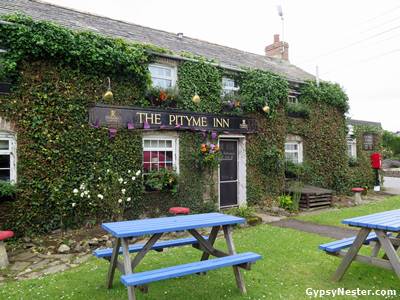 Leaving the flora and fauna behind we returned to human habitat in the pastoral village of Pityme. The name is said to come from a tragic tale of loss at sea.
Leaving the flora and fauna behind we returned to human habitat in the pastoral village of Pityme. The name is said to come from a tragic tale of loss at sea.
The skipper of a fishing vessel set despite despite threatening weather, resulting in all hands being lost. The grieving women of the town went to the widow of the captain and berated her for her husband’s irresponsibility. However, she was distraught as well and explained: “I have lost my husband too, so you should also pity me.”
Whether the legend contains a grain of truth or not we may never now, but it does make for a good story. Certainly better than the account of how Rock got its name. Some seen hundred years ago it was known as Blaketorre, or Black Tor, meaning black rock, which was eventually shortened to just plain Rock.
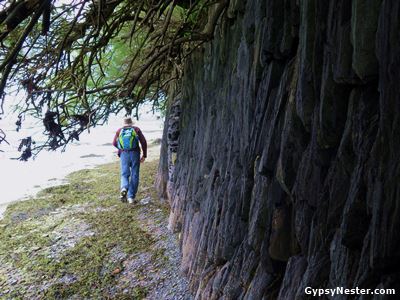 Entering the town along the beach we could see some of the namesake stones along the shoreline, even with the tide rising rapidly. Clearly, we didn’t have time to dawdle or we would be the ones asking for pity while we washed away to sea.
Entering the town along the beach we could see some of the namesake stones along the shoreline, even with the tide rising rapidly. Clearly, we didn’t have time to dawdle or we would be the ones asking for pity while we washed away to sea.
So as much as we enjoyed our exploration of the area around Rock, we had to roll if we were going to catch our ferry back across the bay.
David & Veronica, GypsyNester.com



Hi The GypsyNesters,
I saw you tweeting about travel and I thought I’d check out your website. I really like it. Looks like The GypsyNesters has come a long way!
This looks like a great walk. And I could relate to the before and after tide picture. It was in Cornwall over two decades ago where my daughter and step-daughters got a first-hand lesson in tides. When we pulled our rented motorhome into a campground at Porth Beach in the early evening, the water lapped the edge of the road beside the campground. The next morning when we hit the beach, we walked and walked and walked to get to the water’s edge.
Hi Donna, it was the first of many great walks on this trip. The tide was surprising. Not quite Bay of Fundy huge, but surprising none the less.